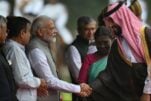
Russia is back in the Middle East, and is close to regaining the position it had until 1973, when Egyptian President Anwar Sadat switched allegiance from the Soviet Union to the United States of America (US).
The cooperation between Russia and Iran, which started over a decade ago, has been consolidated in Syria, the last vestige of the previous Soviet sphere of influence in the Middle East. The two countries have been successful in keeping Bashar al-Assad in power and changing the course of events in his favour. Russia has also helped Iran develop its nuclear programme, and forged strong military and economic ties. Seconded by Iran, Russia re-entered the Middle East.
Today, Russia has a presence in almost all of the Soviet Union’s former zones of influence, namely Syria, Egypt, Iraq, Yemen, Libya and Algeria. Furthermore, it is getting closer to the other non-Arab hegemon apart from Iran; Turkey.
Moreover, Russia is getting closer to countries which were previously considered traditional US allies. Turkey is the most famous example, but Israel, the United Arab Emirates and Saudi Arabia are others. Tunisia is also receiving regular visits from Russia.
What we are witnessing, in fact, is the return of Russia, after two decades of hibernation, to the world stage. Russia, heir of the Soviet Union, has been publicly humiliated by America and American allies since the late 1980s: the Soviet defeat in Afghanistan, the Eastern and Central European revolutions, Iraq, Yugoslavia, the Colour Revolutions, etc. The latest such humiliations came in 2011, when NATO pushed for the toppling of the regime in Libya, and in 2014, when the EU backed the anti-Russian revolution in Ukraine.









